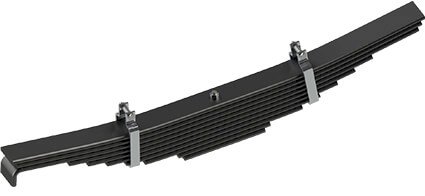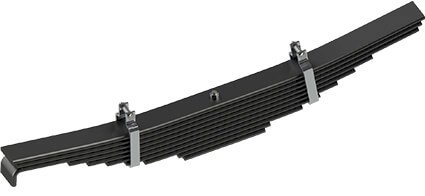Trailer Springs: Everything You Need to Know
Trailer springs are an essential component of any trailer's suspension system.

Trailer springs are an essential component of any trailer's suspension system. They provide support for the trailer's weight, absorb shock and vibration, and help to distribute weight evenly across the trailer's axles. If you're in the market for a new trailer or need to replace your existing leaf springs, it's important to know what to look for and how to maintain them. In this article, we'll cover the basics of trailer leaf springs and what you need to know to keep them in top condition.
What Are Trailer Springs?
Trailer leaf springs are a type of suspension system that use multiple layers of curved metal strips, or leaves, to provide support and flexibility. Like conventional leaf springs, they're typically made of steel, and the number of leaves in a spring can vary depending on the weight and load capacity of the trailer. Most trailers have two or three leaf springs per axle, with each spring providing support for half of the trailer's weight.
How Do Trailer Leaf Springs Work?
 When a trailer with leaf springs travels over a bump or uneven surface, the weight of the trailer is transferred to the springs. The leaves of the spring compress, absorbing the shock of the bump and distributing the weight evenly across the entire length of the spring. As the trailer moves forward, the compressed leaves expand and return to their original shape, providing a smooth ride for the driver and passengers.
When a trailer with leaf springs travels over a bump or uneven surface, the weight of the trailer is transferred to the springs. The leaves of the spring compress, absorbing the shock of the bump and distributing the weight evenly across the entire length of the spring. As the trailer moves forward, the compressed leaves expand and return to their original shape, providing a smooth ride for the driver and passengers.
What Are the Different Types of Trailer Leaf Springs?
There are several different types of trailer leaf springs, including:
Slipper Springs: Slipper springs have a curved end that slides into a hanger bracket, and a flat end that rests against the axle. They're commonly used in light-duty trailers, and are easy to install and maintain.
Double-Eye Springs: Double-eye springs have two curved ends that fit into hanger brackets on either side of the axle. They're commonly used in heavier-duty trailers, and provide a smoother ride compared to slipper springs.
Tandem Axle Springs: Tandem axle springs are designed to provide support for trailers with two axles. They consist of two leaf springs per axle, and are often used in larger trailers that carry heavier loads.
What Are the Advantages of Trailer Leaf Springs?
Durability: Trailer leaf springs are known for their durability and ability to handle heavy loads. They're able to withstand the stress of constant weight and movement, making them ideal for use in commercial and heavy-duty trailers.
Cost-effective: Compared to other types of suspension systems, trailer leaf springs are relatively inexpensive to manufacture and repair. This makes them an affordable option for many trailers, especially those used for commercial purposes.
Simplicity: Trailer leaf springs are simple in design and construction, making them easy to install and maintain. They do not require complex hydraulic or pneumatic systems, and can be repaired with basic tools and equipment.
What Are the Disadvantages of Trailer Leaf Springs?
Rough Ride: Due to their stiffness and lack of adjustability, trailer leaf springs can provide a rougher ride compared to other types of suspension systems, such as air or coil springs.
Limited Adjustability: Trailer leaf springs have limited adjustability, which can make it difficult to fine-tune the suspension system for different road conditions and trailer loads.
Weight: Trailer leaf springs are heavier compared to other types of suspension systems, which can affect the overall weight and handling of the trailer.
How Do You Maintain Trailer Leaf Springs?
To ensure that your trailer leaf springs are in top condition, it's important to perform regular maintenance. This includes:
Inspect the springs regularly: It's important to inspect your trailer leaf springs regularly for signs of wear or damage, such as cracks, corrosion, or broken leaves. Check for any signs of bending or distortion in the springs as well. If you notice any damage or wear, replace the springs as soon as possible.
- Lubricate the springs: Lubricating your trailer leaf springs is essential to prevent rust and corrosion from building up on the metal surfaces. Use a high-quality lubricant such as lithium grease or silicone spray to coat the springs, and make sure to lubricate the spring shackles and pivot points as well.
- Check the alignment: Proper alignment of your trailer's axles and leaf springs is essential for maintaining proper weight distribution and preventing uneven tire wear. Use a tape measure to check the distance between the center of the wheel on each side of the trailer. If there is a significant difference in measurement, the trailer may need to be realigned.
- Balance the load: Distribute the load on your trailer evenly to prevent excess stress on the leaf springs. Overloading one side of the trailer can cause the leaf springs on that side to wear out faster than the other side.




































